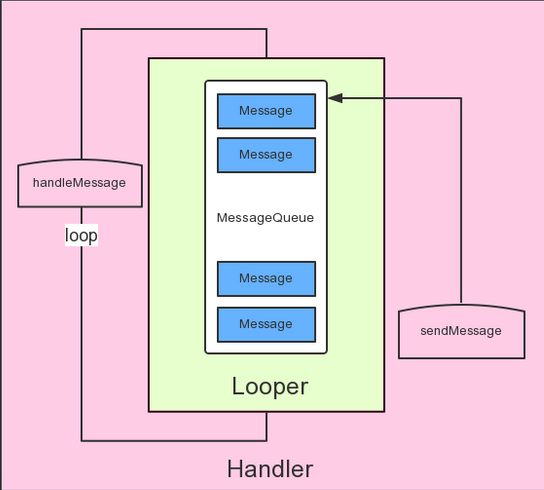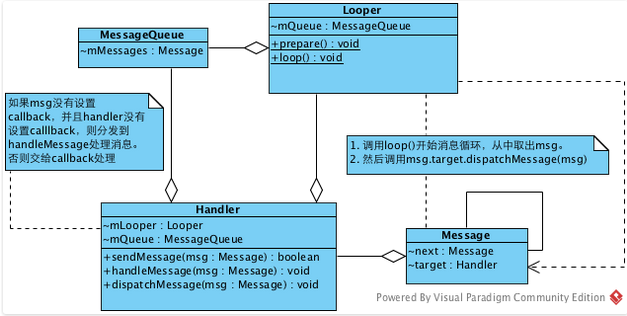Handler概述
Handler在Android开发中非常重要,最常见的使用场景就是在子线程需要更新UI,用Handler来投递消息到主线程执行UI更新操作。因为Android系统的View是非线程安全的,所以需要在主线程更新UI。总的来说Handler就是用来做线程间通信,在不同线程之间传递消息。
消息循环主体结图例
从图中可以看出,四种颜色分别代表了四个对象,并且大致描述了几个对象之间的关系,以及消息的流转过程,首先Handler通过sendMessage将消息投递给MessageQueue,Looper通过消息循环(loop)不断的从MessageQueue中取出消息,然后消息被Handler的dispatchMessage分发到handleMessage方法消费掉。
消息循环中涉及的重要对象
Handler
通过Handler的sendMessage等方法来投递消息到MessageQueue,通过handleMessage来消费Message。Handler必须要有一个已经prepare好的Looper对象,也就是说必须调用了prepare方法(也包括prepareMainLooper方法),究其根本是初始化一个消息队列,这一过程将在下文中详细分析。
Looper
Looper负责从MessageQueue中取出消息,然后通过执行message.target.dispatchMessage()消费掉这个消息,这里的target就是Handler。
MessageQueue
消息队列,管理Handler投递过来的消息。
Message
用来承载数据的消息,最终被Handler消费掉。
UML类图
通过上面的类图可以清晰的了解各个类之间的关系。然后再来分析一下源码。
Handler的创建
public Handler(Callback callback, boolean async) {
if (FIND_POTENTIAL_LEAKS) {
final Class<? extends Handler> klass = getClass();
if ((klass.isAnonymousClass() || klass.isMemberClass() || klass.isLocalClass()) &&
(klass.getModifiers() & Modifier.STATIC) == 0) {
Log.w(TAG, "The following Handler class should be static or leaks might occur: " +
klass.getCanonicalName());
}
}
mLooper = Looper.myLooper();
if (mLooper == null) {
throw new RuntimeException(
"Can't create handler inside thread that has not called Looper.prepare()");
}
mQueue = mLooper.mQueue;
mCallback = callback;
mAsynchronous = async;
}- 在上面这段代码中,首先是检查是否存在潜在的内存泄漏,如果该类是匿名内部类,或者是成员类且没有static修饰符时那么打印一个内存泄漏风险警告。这是由于这种类型的class持有外部类的this引用,可能导致外部类无法释放。
- 接下来就是对成员变量mLooper赋值,在文章开头就提到过,这篇文章中提到的handler对象时在主线程(UI线程)中创建,而Android主线已经有一个消息队列了,所以直接将mLooper.mQueue赋给Handler的mQueue。
主线程MessageQueue的创建
public static void prepare() {
prepare(true);
}
public static void prepareMainLooper() {
prepare(false);
synchronized (Looper.class) {
if (sMainLooper != null) {
throw new IllegalStateException("The main Looper has already been prepared.");
}
sMainLooper = myLooper();
}
}
private static void prepare(boolean quitAllowed) {
if (sThreadLocal.get() != null) {
throw new RuntimeException("Only one Looper may be created per thread");
}
将looper对象装入ThreadLocal中,Handler就是从它里面取出looper对象的
sThreadLocal.set(new Looper(quitAllowed));
}
private Looper(boolean quitAllowed) {
//创建消息队列
mQueue = new MessageQueue(quitAllowed);
mThread = Thread.currentThread();
}UI线程在创建的时候,会调用prepareMainLooper()这个方法,创建一个不退出的消息队列。所以prepareMainLooper这个方法自己永远也不要调用,它是系统调用的,如果我们需要用自己的消息队列呢?那么就应该调用prepare()方法。
Message在MessageQueue的流转
整个消息循环系统中的几个重要部件的创建都已经明白了,那么消息时怎么循环起来的,又是如何消费的呢?来看看下面是loop源码的一部分关键代码。代码非常简单易懂,就是从消息队列中取出消息,然后通过msg.target.dispatchMessage(msg)将消息投递到Handler。
public static void loop() {
final Looper me = myLooper();
if (me == null) {
throw new RuntimeException("No Looper; Looper.prepare() wasn't called on this thread.");
}
final MessageQueue queue = me.mQueue;
Binder.clearCallingIdentity();
final long ident = Binder.clearCallingIdentity();
for (;;) {
Message msg = queue.next(); // might block
if (msg == null) {
// No message indicates that the message queue is quitting.
return;
}
msg.target.dispatchMessage(msg);
msg.recycleUnchecked();
}
}Message被主线程消费
public void dispatchMessage(Message msg) {
if (msg.callback != null) {
handleCallback(msg);
} else {
if (mCallback != null) {
if (mCallback.handleMessage(msg)) {
return;
}
}
handleMessage(msg);
}
}当消息循环中取出的消息被再次传递给Handler的时候,这个消息就走到了生命的尽头(并不代表对象销毁,有一个消息池来回收消息),从dispatchMessage方法可以看出,消息最终的归宿有三个,一是消息自身的callback接口,二是handler的callback接口,最后是handleMessage接口。
具体实例:
1、自定义线程相关handler使用:
class MyThread extends Thread {
public Handler handler;
@Override
public void run() {
Looper.prepare(); //new 一个Looper对象
handler = new Handler() { //拿到当前线程的 Looper 对象
@Override
public void handlerMessage(Message msg) {
// TODO Auto-generated method stub
System.out.println("current thread:" + Thread.currentThread());
}
};
Looper.loop();//开始死循环处理消息
};
}2、主线程与子线程之间的信息交互
//创建主线程的Handler
private Handler mHandler = new Handler() {
public void handleMessage(Message msg) {
Message mssage = new Message();
System.out.println("main Handler");
//向子线程发送消息
threadHandler.sendMessageDelayed(message, 1000);
};
};
//创建子线程的 handler
private Handler threadHandler;
@Override
protected void onCreate(Bundle saveInstanceState) {
super.onCreate(savedInstanceState);
setContentView(R.layout.main);
HandlerThread thread = new HandlerThread("handlerThread");
//创建子线程的 handler
threadHandler = new Handler(thread.getLooper()) {
public void handlerMessage(Message msg) {
Message message = new Message();
//向主线程发送消息
mHandler.sendMessageDelayed(message, 1000);
};
};
}参考链接:
http://vjson.com/wordpress/handler-looper%E5%8E%9F%E7%90%86%E5%88%86%E6%9E%90.html
http://it.51xw.net/mobile/2015/04/86.html
























 1477
1477











 被折叠的 条评论
为什么被折叠?
被折叠的 条评论
为什么被折叠?








